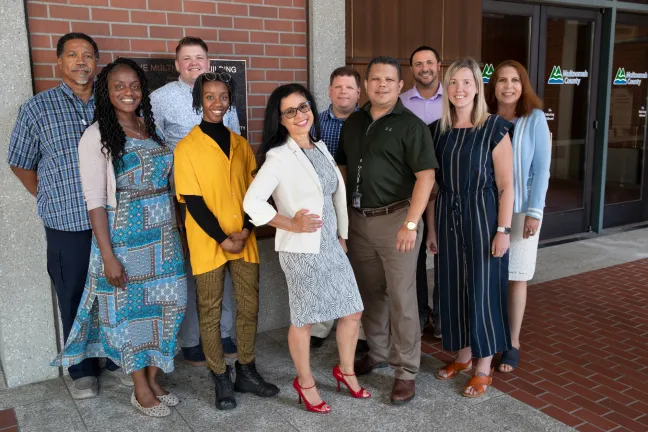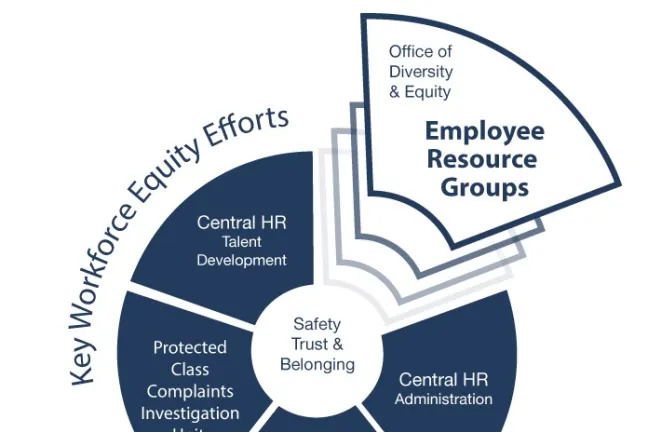On Sept. 4, Chair Kafoury shared the following message with employees regarding the progress of the County's workforce equity efforts:
At Multnomah County, we’re deeply committed to our workforce equity effort, which is why I’m so pleased to announce that we have hit one of the major milestones outlined in our strategic plan.
Thanks to the tireless efforts of our Employee Resource Group stakeholders, the Office of Diversity and Equity, Labor Relations, and Local 88, we are now able to offer employees more County time to dedicate to Employee Resource Group activities.
Since their inception, Employee Resource Groups at the County have been an invaluable tool for our workforce. These employee-run groups promote diversity and the values and efforts of the County while supporting personal and professional growth for employees. By convening employees with common interests and shared goals, Employee Resource Groups improve workforce retention and provide a strong sense of community among staff.
The work of our current Employee Resource Groups — including Multnomah County Employees of Color, Managers of Color, QTPOC (Queer and Trans People of Color), PRISM, IDEA (Including Disability in Equity and Access), Immigrants and Refugees, Family Advocates of Multco, Vital Aging Network, and Veterans Employee Resource Group — is far-reaching.
Participation opportunities include:
Celebrating cultural holidays and observances
Identifying and solving barriers to employee engagement
Helping the County with employee recruitment and development, diversity awareness, and strategic planning
Hosting events that create opportunities for employees to build stronger workforce communities through networking and sharing their skills
And now, under the updated version of Personnel Rule 3-75, employees will have more time to engage in those opportunities. Changes of note include:
- Employee Resource Group members may now spend a maximum of six hours per month for Employee Resource Group business on County time. This is up from three hours in the previous personnel rule.
- Those in leadership positions in Employee Resource Groups may spend eight hours of County time per month on Employee Resource Group business, with the exclusion of co-chairs.
- Employee Resource Group co-chairs may spend 12 hours of County time per month on Employee Resource Group business. This is up from the six hours previously allotted to Resource Group leadership and co-chair positions.
- Employee Resource Group members will make every reasonable attempt to provide 15 calendar days’ notice to their supervisor to participate in group business.
- Denials or recensions of Employee Resource Group participation will be referred to the department director, and those decisions will be shared with the Chief Diversity and Equity Officer.
This update to the Employee Resource Group personnel rule directly addresses a performance measure outlined in Focus Area 3 of the
Please know these changes were not crafted in a vacuum. To ensure Employee Resource Groups had an impactful voice in the process, one leader from each group was asked to sit on the Workforce Equity Strategic Plan Employee Resource Group subcommittee.
As part of their participation in the subcommittee, resource group representatives worked diligently to gain input from their membership via surveys and conversations, as well as from Human Resources, department directors and central County leadership to ensure this effort was as equitable and inclusive as possible.
The final draft of the updated personnel rule was presented July 1 to Labor Relations and Local 88. And last week, I had the pleasure to sign and make official this revised policy.
Employee Resource Groups are essential to improving our leadership development process at the County and ensuring that our business and diversity efforts are aligned. Our hope is that these changes make it easier for employees to get involved with Employee Resource Groups and provide even more opportunities for Employee Resource Groups to positively impact our organizational culture and sense of community.
Thank you to those who have contributed to this update, as well as any employee who has contributed a piece of themselves to help make Multnomah County a workplace that is inclusive and embodies safety, trust and belonging.



